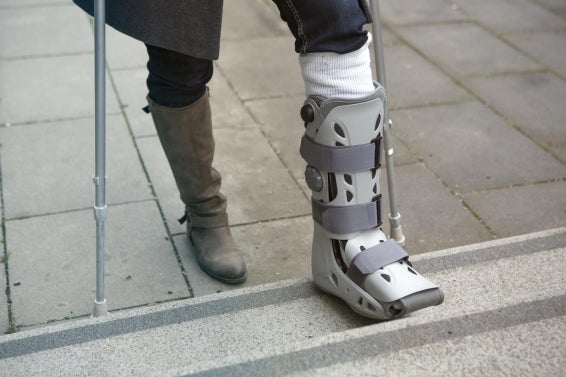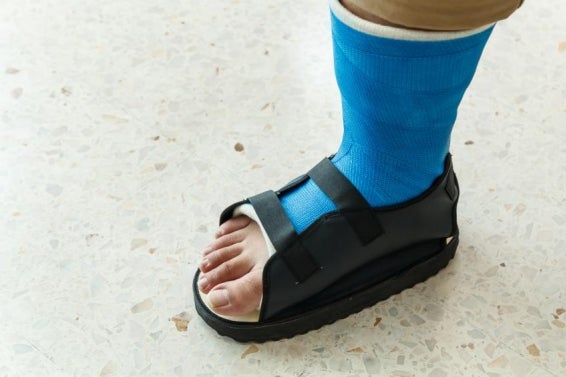What are foot and ankle treatments?
Foot and ankle treatments are surgeries and procedures to treat several conditions and injuries affecting the feet and ankles. The foot and ankle is a complex area containing bones, ligaments, tendons, nerves and muscles. Amazingly, these components come together to form 33 joints. Treating problems with any of these structures can involve ankle, foot or toe surgery.
Common types of foot and ankle treatments include:
- Ankle arthroscopy is a minimally invasive surgical method of diagnosing and treating many ankle symptoms and problems from torn or weak ligaments to fractures.
- Ankle replacement surgery removes a diseased or damaged joint and replaces it with an artificial joint.
- Foot and ankle fracture and dislocation treatment may be necessary when a bone in the ankle is dislocated out of place or part of the bone has broken off.
- Foot and ankle ligament and tendon reconstruction including Achilles tendon surgery repairs or reconstructs torn or weak ligaments.
Why are surgical foot and ankle treatments performed?
For some conditions, a foot specialist—a podiatrist—will first try to resolve the problem with nonsurgical foot and ankle treatments, such as a course of physical therapy. When nonsurgical foot and ankle pain treatments aren’t enough, your doctor may recommend surgery to relieve pain. Surgery is also necessary to correct physical problems with any of the foot or ankle structures. The general treatment goals are to improve ankle or foot function, reduce disability, and improve your quality of life. Common foot and ankle conditions that may require surgery include:
- Acute injuries including fractures, dislocations, torn cartilage, and ligament or tendon tears
- Bone spurs
- Degenerative joint disease including arthritis
- Inflammatory forms of arthritis including rheumatoid arthritis and psoriatic arthritis
- Overuse injuries including plantar fasciitis
- Synovitis, which is inflammation of the lining of the joint
- Unexplained ankle or foot symptoms including pain; foot and ankle swelling; and joint locking, catching or grinding
Who performs foot and ankle surgery?
Orthopedic surgeons and foot and ankle surgeons commonly perform foot and ankle treatments. Orthopedic surgeons treat, prevent and rehabilitate bone and joint problems. In addition to surgery, they also use medical approaches to manage these types of problems. Foot and ankle surgeons are either orthopedic surgeons or podiatrists who further specialize in surgery of the foot, ankle, and lower leg.
How is foot and ankle surgery performed?
Orthopedic surgeons and foot and ankle surgeons commonly perform foot and ankle treatments. Orthopedic surgeons treat, prevent and rehabilitate bone and joint problems. In addition to surgery, they also use medical approaches to manage these types of problems. Foot and ankle surgeons are either orthopedic surgeons or podiatrists who further specialize in surgery of the foot, ankle, and lower leg.
Foot and ankle treatments typically take place in a hospital or surgical center. Many foot and ankle treatments are major surgeries with significant recoveries. Your doctor may use either an open surgery technique or a minimally invasive procedure, depending on the underlying problem and the surgical complexity.
While some of these treatments are outpatient surgeries, most will involve general anesthesia. This lets you sleep through the procedure. In some cases, regional anesthesia with sedation may be an option. Ankle arthroscopy is an example.
What to expect the day of your foot and ankle treatment
In general, this is what happens the day of your surgery:
- You will meet with a preoperative nurse in an exam room. The nurse will ask you to change into a hospital gown and may perform a brief exam, such as checking your blood pressure and other vital signs.
- The anesthesiologist or nurse anesthetist will ask about your medical history and explain the anesthesia you will have.
- A nurse will likely start an intravenous (IV) line in your arm to administer medicines and fluids if necessary.
- You will get a sedative to help you relax before the team takes you to the operating room (OR).
- At some point before the team administers anesthesia, your surgeon will visit with you and review the procedure. This is the time to ask any last-minute questions you have about the surgery.
- Your team will start anesthesia in the OR. With general anesthesia, you won’t remember anything else until you wake up in the recovery room.
For minor surgeries, you should be able to go home after the procedure. For major foot and ankle surgeries, you may need to stay in the hospital for several days. For both types, your team will give you detailed instructions about activity level, medications, and follow-up appointments before you leave.
What are the risks and potential complications of foot and ankle surgery?
Any time you have surgery, there are risks and the possibility of complications. Some of these can be serious and may develop during surgery or recovery. In most cases, the benefits of the surgery outweigh the risks, and people with successful outcomes see a significant improvement in their quality of life. Still, it’s important to understand all the risks specific to you and the surgery you will have. Ask your surgeon if you need clarification.
General risks of surgery
The general risks of surgery include:
- Anesthesia complications including breathing problems
- Bleeding, blood loss, and blood clots
- Infection
Potential complications of foot and ankle treatments
Most foot and ankle surgeries are successful, but potential complications include:
- Continued pain, stiffness or disability
- Decreased athletic performance or difficulty walking
- Development of arthritis
- Failure to heal or poor healing
- Dislocation of the new ankle joint
- Nerve, muscle, or blood vessel damage
- Scarring of the tendon
Reducing your risk of complications
You can reduce your risk of certain complications by:
- Understanding and adhering to your surgeon’s instructions and advice for medications, activities, diet, and lifestyle habits before surgery and during your recovery
- Telling your doctor about any unexpected symptoms, such as bleeding, fever or chills, or increase in pain
- Sharing your complete medical history and telling all members of your care team if you have allergies
How do I prepare for foot and ankle surgery?
Taking the time to prepare for surgery can make your recovery more comfortable, improve your chances of successful treatment, and reduce your risk of complications. Preparing for foot and ankle treatments includes:
- Arranging for a ride home and for someone to stay with you the first 24 hours.
- Getting preoperative testing if your doctor orders it. This will vary depending on the procedure and your medical history.
- Losing excess weight before surgery
- Making sure all your healthcare providers have your complete medical history. This includes chronic conditions, allergies, and medications. When listing medications, include prescriptions, over-the-counter drugs, herbal treatments, and vitamin supplements.
- Not eating or drinking before surgery as directed
- Stopping smoking as soon as possible to help the healing process
- Taking or stopping medications as directed; request written directions if the situation is complex
Questions to ask your doctor
Making a list of questions can help you remember them during your appointments. Questions you may want to ask your doctor include:
- Why do I need the treatment you are recommending? Are there any other options we can try first?
- How long will the surgery take? When can I go home?
- Will I have to use a splint, cast, or walking boot?
- What restrictions will I have after surgery? Will I need help at home?
- When can I return to work and other activities?
- When will I start physical therapy and how long does it last?
- How will you manage my pain?
- What changes, if any, to my medication plan do I need to make?
- When should I follow up with you?
- How should I contact you after hours if I have a problem?
What can I expect after foot and ankle surgery?
Knowing what to expect after surgical foot and ankle treatment makes it easier to plan and prepare for a successful recovery.
How long will it take to recover?
You may need to wear a cast or walking boot for a few weeks after surgery. Crutches will help you keep weight off the foot and ankle while you heal. Physical therapy is usually part of recovery. It will help you regain strength and movement in the foot and ankle. You will gradually return to normal activities over several weeks. Full recovery can take several months, even up to year, depending on the specific condition and procedure. Follow your doctor or therapist’s instructions about bearing weight and returning to activities. Doing too much too fast can set back your recovery.
Will I feel pain?
Pain and discomfort is a reality after foot and ankle surgery. Controlling pain is important for healing and a smooth recovery. It will allow you to complete rehabilitation activities that are necessary for your recovery. Tell your doctor if your pain worsens or changes in any way. This could be a sign of a complication.
When should I call my doctor?
If you have questions or concerns between appointments, contact your doctor’s office to find the answers.
You should call your doctor right away or seek immediate medical care if you have any of the following symptoms:
- Breathing problems or shortness of breath
- Confusion or changes in level of alertness
- Chest pain, pressure or tightness
- Drainage of pus, redness or swelling around your incision
- Fever. It’s common to have a fever right after surgery. Your doctor will give you instructions about when to call for a fever.
- Inability to urinate, move your bowels or pass gas
- Leg pain, redness or swelling, which could mean you have a blood clot
- Unexpected bleeding
How might foot and ankle surgery affect my everyday life?
Most people successfully return to favorite activities and independence after foot and ankle surgery. The results may depend on the amount of damage present in the foot or ankle before surgery. With severe damage, you may notice less leg or ankle strength than before the injury. With ankle replacement, you may need to avoid contact sports and other high-impact activities. Talk with your doctor before surgery so you know what to expect after recovery.





